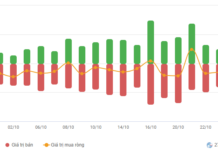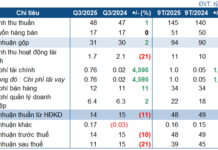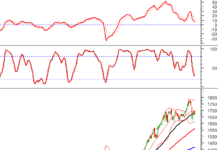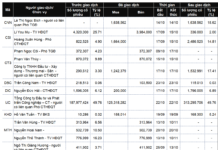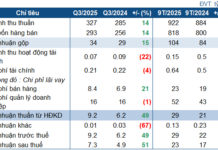
Banks forced to increase non-interest income
Commenting on the banking sector, Associate Professor Dr. Nguyen Huu Huan, a lecturer at the University of Economics in Ho Chi Minh City, stated that while it is impossible to accurately calculate the actual non-performing loans in banks at present, they are certainly much higher than the published figures.
The banking industry’s profits this year are likely to match or exceed last year’s, but the rate of profit growth will be slower than in previous years. Banks will have to find ways to increase non-interest income, as interest income will face challenges due to credit growth issues.
Non-interest income has already decreased compared to previous periods, as bancassurance and bond sales have declined significantly. Credit growth is also facing challenges, forcing banks to increase non-interest income through financial techniques such as M&A, selling companies or shares, and using financial techniques to generate extraordinary non-interest income. Actual non-interest income sources such as insurance or bonds will be difficult as these channels are frozen.
According to the profit plan set by the banks for this year, while it is not significantly higher than last year’s results, it can be seen that profits will vary across banks by the middle of the year. Some banks are on track to meet their targets, while others seem unlikely to achieve them.
Associate Professor Dr. Dinh Trong Thinh, an economic expert, stated that credit is one of the most critical issues for the banking system. While it is important and necessary for the system to promote lending, the State Bank of Vietnam (SBV) and commercial banks continue to prioritize ensuring the safety of credit activities. In reality, while banks aim to boost credit, they must also ensure that they meet the lending criteria set by the SBV. As a result, credit growth may improve, but credit quality must not deteriorate. This is something that commercial banks remain cautious about. Surely, in the second half of the year, credit will improve compared to the first half. The critical question is whether businesses have sufficient conditions to access this credit package.
Additionally, the demand for capital will increase due to improvements in exports, imports, and business performance. The government has already reduced various taxes, fees, and charges, and with an improved business environment, businesses will require more capital. Consequently, credit demand will also grow, contributing to better profit growth for banks.
Non-performing loans increase
Ms. Bui Thi Thao Ly, Director of Analysis at Shinhan Securities Vietnam (SSV), stated that the SBV would maintain a stable interest rate environment in the second half of the year, with the operating interest rate remaining at 3.5 – 4.5%. In a context of slightly increasing deposit interest rates – which is reasonable given the high inflation – banks are forced to increase deposit interest rates to protect the interests of depositors. Ms. Ly expects lending rates to drop slightly by 0.5% or remain stable to stimulate credit growth, as there is significant growth pressure in the second half.
Assuming a slight increase in deposit interest rates and a slight decrease or stabilization of lending rates, NIM for banks is also expected to decrease slightly or remain unchanged compared to 2023. With this estimate, non-performing loans may increase. At the end of 2023, non-performing loans were around 1.7 – 1.8%, and they are estimated to increase to 1.9% by the end of 2024. Balancing macroeconomic factors, bank profits could increase by 15% in 2024.
SSV analyzed that with a non-performing loan ratio sensitivity of 1.6 – 2.1%, the pre-tax profits of listed banks could increase by 10 – 20%. Despite concerns about interest rates, non-performing loans, and narrowing profit margins, the profit growth momentum is expected to continue in 2024.
Profits could increase by 18%
In a recent industry report, Rong Viet Securities (VDSC) stated that 2024 would continue to be a relatively challenging year for the banking industry, but some credit institutions would see improvements in profit growth. In 2024, VDSC estimates a 18% year-on-year increase in pre-tax profits for banks, driven by a 19% growth in interest income due to lower funding costs.
The scale of non-performing loans may slightly decrease by the end of the year as banks improve their pre-provision profit positions compared to 2023, allowing them to further clean up their balance sheets. Additionally, a recovering real estate market will help expedite the handling of collateral for non-performing loans. VDSC anticipates a slower formation of new non-performing loans, based on improved loan servicing capabilities due to lower lending rates across the market and tighter credit policies adopted by banks.
With a recovery in total operating income, banks will have a basis for increasing provisions to enhance non-performing loan management and maintain asset quality. Funding costs for 2024 are expected to vary based on risk appetite and customer segments.
Net interest income will drive the banking industry’s profit growth in 2024. While capital absorption capacity remains weak at the beginning of the year, it is expected to accelerate in the second half of 2024, based on more reasonable lending rates and expected economic recovery, leading to increased demand for production, business, and consumer loans.
In the context of declining funding costs and the time lag in loan repricing, the industry’s NIM will slightly recover and contribute to the growth of net interest income.
VPBank strengthens its system in 2023, laying the foundation for sustainable growth
By 2023, VPBank has made significant strides in expanding its customer base and scaling up its operations. The bank has managed to make progress amidst challenging macroeconomic conditions, focusing its resources on strengthening its system and building momentum for sustainable growth in 2024 and beyond.

